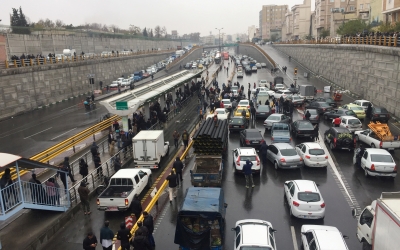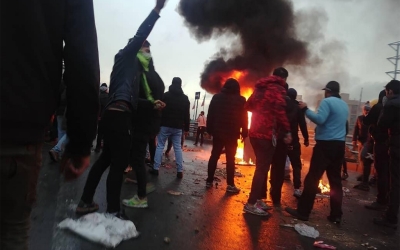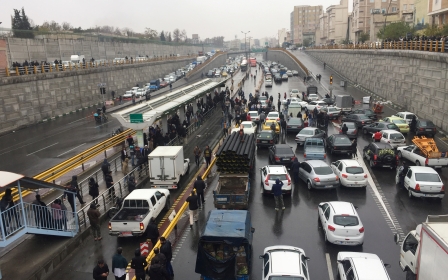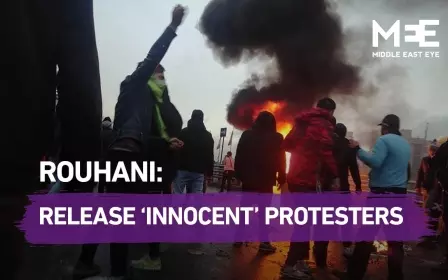'Stuck between inept government and freak Trump': Iranians speak out about protests
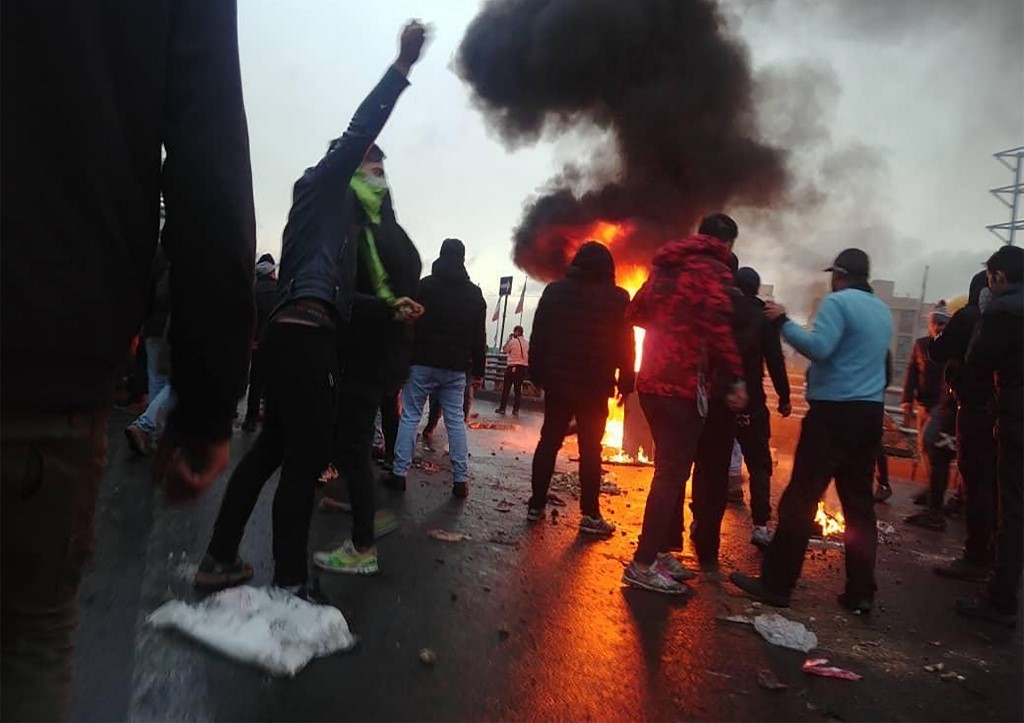
Standing by a junction in the north of Tehran, Masoud is hoping to be called for a day's worth of employment by people passing by looking for workers.
“I was one of the protestors in the recent events as I had been waiting for such a moment to join other people in order to voice my anger and discontent over my condition of life,” said Masoud.
Forty-three and unemployed, Masoud lives in a slum close to Karaj, a city near the capital.
Over the past two years, amid the deterioration of Iran’s economic situation, many people have become unable to pay their rent and been forced to move to the suburbs and slums close to large industrial cities like Tehran.
“I have been unemployed for two years, causing me to be unable to make ends meet and provide my family and two children with a life with at least some quality," Masoud told Middle East Eye.
"During the protests, I saw how people were frustrated and irritated as they were carrying wooden clubs.
“If people gather in large numbers in the cities, I will join them again for sure, as long as our problems aren't addressed.”
It was midnight on 15 November when the government shocked Iranians by announcing it was rationing gasoline and tripling the price.
Without any prior planning, people in many different cities, eventually reaching more than 100 areas of the country, took to the streets to express their anger with the government and the ruling elite.
Hundreds of banks, petrol stations and government buildings were torched during the unrest, including 50 sites used by the security forces, according to the Iranian authorities.
First hours of the protests
Working in Tehran’s bazaar, the economic heart of Iran, Maysam told MEE: “Everything started spontaneously without any planning and preparation.
"What angered people more was that tripling the gasoline price occurred overnight while this should have be done over five or six years.”
Mohsen, a 65-year-old taxi driver, told MEE that he was “stuck” in Piroozi street, a neighbourhood situated in the south of Tehran, as the protests started.
“At first I thought the traffic jams were a result of the snow, but it turned out that the people had blocked the streets,” he said.
“People are fed up with the dire economic situation as they repeatedly hear reports about the corruption scandals of officials.”
Mohsen insisted that those looting the supermarkets weren’t thugs: “I even saw an elderly woman leaving a supermarket with some basic necessities.
"I don’t know why the government doesn’t understand that people are drowning in poverty.
"My life is a symbol of the current situation. Besides the rent, I have to pay the instalments for my car each month.
"I’m now baffled since I don’t know how I will work since the gasoline price has tripled, leading to a decrease in my earnings.”
“We are stuck between the freak president [Donald Trump] of the US, whose heavy sanctions have led many, including my son, to lose their job, and an inept government in Iran which doesn't want to leave us alone by resigning.”
The US imposed sanctions on Iran in May last year after unilaterally withdrawing from a landmark 2015 nuclear deal, causing severe economic problems for the country
Middle class wiped out
Speaking of economic condition in Iran and the repercussions of a hike in gasoline price, an airline employee said: “The incomes of most of the people are low while inflation is soaring.
"With an increase in the fuel price, the price of food and other daily necessities have gone up, and whenever the price of materials goes up they won't come down again.
"The purchasing power of people is at its worse and no one, including me, can keep borrowing money from others.
“Right now, the middle class has been wiped off the face of Iran, and people are either a member of the rich or poor class.
"I believe the majority are feeling the bitter taste of poverty right now.”
While ordinary people’s statements indicate that the protests were out of anger over state corruption, a senior editor in a reformist paper, willing to talk on condition of anonymity, said that people's loss of hope in both reformists and hardliners played a significant role in triggering the protests.
“Over the past two years, the public has reached the conclusion that none of the reformists or hardliners are able to serve them, resulting in the despair of Iranians with both of them.
"In fact, the absence of any sign of positive change brought people on to the streets, and the gasoline price increase acted as a pretext for the people to express their opposition to how the country is being ruled.”
Deadly reaction
From the first day of the protests, the atmosphere was violent, with security forces reported to have opened fire on protesters.
Various reports have been published showing security officers targeted ordinary people, resulting in the deaths of more than 200 protestors, according to Amnesty International.
However, the government and security officials claim that the “enemy” and terrorist groups were the ones shooting at people to create division between the state and people.
Tehran has blamed opposition leaders in exile and its foreign adversaries - Israel, Saudi Arabia and the United States - for helping foment the unrest.
While most parts of the country were affected, the most violent and deadly protests occurred in the southern part of Iran, especially Khuzestan Province.
Speaking on condition of anonymity, a security officer told MEE: “For sure, people chanted harsh slogans out of their concerns over their condition of life.
"I’m also one of them and I have lots of friends with low incomes, not being able to afford the necessities of their life.
"But I could see how Saudi Arabia and its proxy terrorist group Al-Ahwazi [a group that seeks to separate the oil-rich province of Khuzestan from Iran] was riding the waves in Khuzestan.
"That’s why the death toll rose in that area.”
Hopelessness among the young
Payam, who is based in Karaj near Tehran, told MEE: “My sister’s leg was shot from behind while she was on the way home after leaving the university.
"She had no role in the protests and her only fault was standing for a moment watching how things were unfolding.
"We are really worried about the insecurity and what may happen in the future”.
Indeed, a feeling of hopelessness, which had begun to disappear after the 2015 nuclear deal, has recently again become a hallmark of the young generation in Iran.
Following the reimposition of US sanctions after Washington withdrew from the deal, and the consequent damage to Iran’s economy, the shadow of despair has returned.
Slumped in deep dejection, Farzad, a 36-year-old accountant, told MEE: “If I didn’t have a wife and child, I would have left the country by now definitely.
"The only thing that our damn officials are skilled at is to accumulate wealth and money for themselves and their families.
"People like me are always ashamed in front of their families as we can't afford to buy clothes or provide them with the things they want."
In a brief conversation with MEE, an activist in Iran’s mobile application industry said that he was determined to move to Europe as he foresees no “upheaval” or positive change and reform in Iran.
“The week-long internet blackout [imposed during the protests] enhanced my intention to leave the country," he said.
"This disconnectivity frustrated everyone and it could cause a new wave of protests."
Increasing frequency of protests
In an interview with Fararu, a private news agency in Iran, Professor Amanollah Qarai Moghaddam, a sociologist, suggested that the protests will continue to occur across Iran due to to “increased discontent” among people towards the government.
“People feel that they are the only ones carrying the burden of [economic] pressures, while a limited number of persons have access to all the opportunities and privileges," Qarai Moghaddam said.
"[Hence] they lose hope in any [positive] change.
“I dare to say that the issue is neither over gasoline nor [the price of] eggs. Under any similar condition, there is potential for such protests.
“Currently, the protests have gained momentum. If the distance between protests [in the past] was eight years, now this [period of time] has decreased to two years,” said Qarai Moghaddam, referring to the protests in 2009 and late 2017.
This article is available in French on Middle East Eye French edition.
Middle East Eye propose une couverture et une analyse indépendantes et incomparables du Moyen-Orient, de l’Afrique du Nord et d’autres régions du monde. Pour en savoir plus sur la reprise de ce contenu et les frais qui s’appliquent, veuillez remplir ce formulaire [en anglais]. Pour en savoir plus sur MEE, cliquez ici [en anglais].


